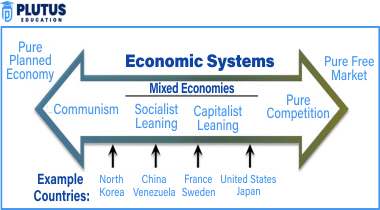A capitalist economy is a system wherein all factors of production—land, labor, capital, and entrepreneurship—are owned by the private individual or firms and operated for profits. It is free market in nature, where prices for goods and services would be determined by the forces of competition and consumer preferences, as well as by demand and supply. Government, too, would play the smallest role possible, with less of an ownership interest and more of a regulatory role.
In this article, we will explore the core principles of a capitalist economy, examine its features, and discuss its impact on global economies.
What is Capitalist Economy?
A capitalist economy finds inspiration from profit and the notion that people or businesses can have ownership in property and control resources. By extension, capitalism generally affords private enterprise the role to play a more dominant function in terms of producing goods and services rather than direct state control. Capitalism encourages innovation and entrepreneurship, as profit is viewed as an essential stimulus to invest in new ventures and technologies. It compares with other forms like socialism or communism, wherein the state has all control over resources and production.
Core Elements
- Private Property: Both individual and corporate property as well as means of production exist.
- Market Economy: Prices of goods and services are determined by free markets
- Profit Motive: Firms operate to maximize profits
- Minimal Government Intervention: The government intervenes by regulating the market.

Features of Capitalist Economy
The defining features of a capitalist economy certainly give it an edge compared with other economic systems. So, these features help shape how the goods are produced, exchanged, or even consumed. They also have an influence over the behavior of both businesses and consumers alike.
Private Ownership
The principle characteristic of a capitalist economy is private ownership. Resources, whether land, factories, or technology, belong to particular individuals or firms. With private ownership, the resources are independently managed in order to control the processes of production.
Profit Motive
Businesses in a capitalist economy are motivated by profit. The desire to earn higher returns drives companies to innovate, reduce costs, and offer better products and services.
Competitive Markets
Competitive growth among businesses is the natural nature of capitalism. Businesses compete to outdo one another over competitive prices to supply all kinds of goods and services. This would allow customers to choose the most convenient ones and spur innovation.
Consumer Sovereignty
Under a capitalist economy, the consumer market is allowed to choose any kind of product or service. Businesses respond to this demand, hence resulting in the diversities of products and services produced.
Limited Government Intervention
In a capitalistic system, the role of the state is minimal; in most cases, it just enforces contracts, protects property rights, and ensures fair competition. It is the noninterference of the state with the freedom to operate under regulatory frameworks that enables the free operation of businesses.
Capital Accumulation
In capitalism, a profit can be recycled into more capital by either businesses or individuals for building up. Hence, this kind of capital can be very crucial in innovation, expansion, and also long-term economic development.
Capitalist Economy Countries
Many countries in the world follow capitalistic economies, and the degree of capitalism varies from country to country. Pure capitalistic countries exist as well as those that combine elements of capitalism and socialism.

1. United States: The best example of a capitalist economy is the United States. This is characterized by widespread private business ownership and a lack of governmental interference in economic activities.
2. Germany: Germany exemplifies a social market economy—a system that has equal constituents of capitalism as well as welfare plans. Germany has free markets but, at the same time, ensures social security for its people.
3. Japan: Japan is a capitalist economy that is accompanied by private ownership and extreme competition in the market, however, government sectors also regulate most industries as well as ensure the economy is stable.
4. United Kingdom: The United Kingdom, like the U.S., is a mixed capitalist economy where the private sector is strong but the government intervention is there in areas like healthcare and education.
5. South Korea: It continues to be an active capitalistic economy based on state-of-the-art technologies, export-driven industries, and private sectors.
Merits and Demerits of Capitalist Economy
Like any economic system, capitalism has its advantages and disadvantages. These affect various aspects of society, including wealth distribution, innovation, and individual freedoms.
Merits
- Economic Efficiency: Resources are put to best possible use, and productivity improves because of intense competition and consumer sovereignty.
- Innovation and Growth: Profit motive instigates entrepreneurships toward innovation and improvement in their products and services, which leads to the growth of the economy as well.
- Consumer Choice: Consumers are offered a wide variety of goods and services catering for different tastes and the needs of consumers.
- Creation of Wealth: Capitalist economies tend to create wealth, thereby raising standards of living for many citizens.
Demerits
- Income Inequality: Much criticism has been hurled against capitalism due to factors such as income inequality, where a significant portion of the people may be pretty poor, and a few are very rich.
- Market Failures: There can be monopolies, environmental degradation, and labor exploitation if the market mechanisms are not regulated.
- Economic Instability: Booms and recessions, causing unemployment and economic instability may well haunt capitalist economies.
Difference Between Capitalist Economy and Socialist Economy
Socialist economy differs from capitalist economy in aspects of ownership and control, and also in objectives. Both systems offer a way of raising standards of living but this is approached differently.
| Aspect | Capitalist Economy | Socialist Economy |
|---|---|---|
| Ownership | Private ownership of resources and businesses | State ownership of means of production |
| Economic Planning | Market-driven, decentralized decision-making | Centralized planning by the government |
| Profit Motive | Businesses operate for profit | Production based on social needs rather than profit |
| Wealth Distribution | Unequal distribution, merit-based | Equal distribution of wealth, focus on reducing inequality |
| Role of Government | Limited role, ensures fair competition | Significant role, controls major industries |
Role of Money in Capitalist Economy
Money in capitalism assumes a central place in the performance of economic activity within a capitalist economy. Money facilitates making some goods or services substitutes for others. It provides liquidity, thereby making easy the transformation of one good into another. Money helps meet short-run costs or makes for ease of computation by basing calculation and decisions on the satisfaction of wants.
1. Medium of Exchange: Money makes the exchange of goods and services quite easy and smooth. It eliminates barter of goods and services, making an exchange process much more efficient.
2. Store of Value: Money acts as a store of value, enabling the actual individuals and business units to save and increase their wealth for future use. This ability to save provides incentives for investment and economic growth.
3. Unit of Account: Money standardizes value, which helps one make commodity and service comparisons as well as price them easily in the economy.
4. Capital Formation: In a capitalist economy, money is essential for capital formation. It enables business investment in new technologies, business expansion, and risky innovation.
Conclusion
One of the most dynamic economic systems with sheer innovation, competition, and wealth-creation capabilities is the capitalist economy. However, with these comes the drawbacks of income inequality and market instability. Balancing such benefits with regulation should be considered in efforts to promote economic stability along with social equity.
Capitalist Economy FAQs
What are the main characteristics of a capitalist economy?
A capitalist economy features private ownership, competitive markets, profit motives, and limited government intervention.
Which countries have capitalist economies?
Countries like the United States, Germany, Japan, and the United Kingdom have capitalist economies.
How does a capitalist economy differ from a socialist economy?
A capitalist economy is based on private ownership and profit, while a socialist economy focuses on state ownership and equal wealth distribution.
What role does money play in a capitalist economy?
Money acts as a medium of exchange, store of value, unit of account, and facilitates capital formation in a capitalist economy.
What are the disadvantages of a capitalist economy?
Some disadvantages include income inequality, market failures, and economic instability.


